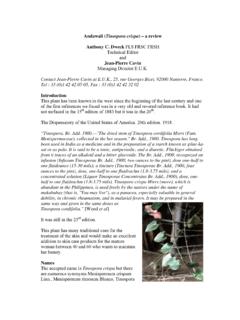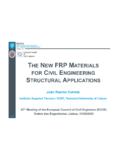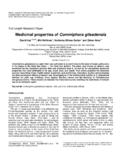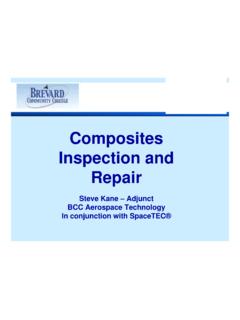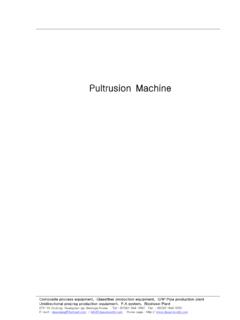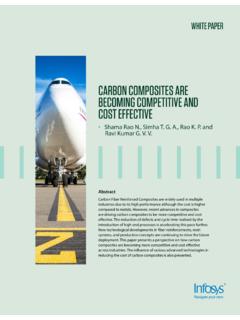Transcription of Guide to Resin Infusion - Carbon Mods
1 Guide to Resin Infusion Guide to Resin Infusion Introduction Vacuum Resin Infusion is a sophisticated technique for manufacturing high performance, void free composites even on large or complicated moulds. The process is ideally suited to the manufacture of Carbon fibre composites and is widely used by professional manufacturers for the production of Carbon fibre body panels such as bonnets and by marine manufacturers for the production of boat hulls. In Resin Infusion , reinforcement is laid into the mould dry', without any Resin , and then enclosed in a specially configured stack of bagging materials (such as peel ply, Infusion mesh and bagging film) before being subjected to vacuum pressure using a composites vacuum pump. Once all the air has been removed from the bag and the reinforcement has been fully compressed under this pressure, liquid epoxy Resin (mixed with hardener) is introduced to the reinforcement through a pipe which then infuses through the reinforcement under the vacuum pressure.
2 Once the Resin has fully infused through the reinforcement, the supply of Resin is cut off (using a pipe clamp) and the Resin is left to cure, still under vacuum pressure. Advantages of Resin Infusion Resin Infusion , when done correctly, can produce parts of incredible strength and quality of appearance. The combination of vacuum pressure along with carefully placed vacuum consumables (such as peel-ply and Infusion mesh) mean that the finished composite will have absorbed Resin at the optimum Resin -to-reinforcement ratio, avoiding Resin -rich composites or variations in performance inevitable with traditional wet-lay manufacture. The Resin Infusion process also eliminates some of the problems that can blight wet-lay composites, such as air voids (caused where the reinforcement has bridged around tight corners) and tiny air bubbles caused by air trapped within the laminate. The quality of epoxy Infusion resins' means that Resin infused parts can be made with strength to weight ratios that can rival parts made using pre-impregnated (pre-preg) reinforcement systems.
3 Guide to Resin Infusion Page 1 of 12. 2010 Carbon Mods No reproduction without permission - Guide to Resin Infusion The Starter Kit Contents Components/material Purpose Composites vacuum pump Electric powered vacuum pump capable of very high vacuum pressure ( vacuum). This pump creates the vacuum pressure that draws all of the air out of the vacuum bag and maintains this vacuum pressure throughout the cure cycle of the composite. Resin catch pot & liners The catch pot sits between the composite and the vacuum pump and prevents any excess Resin from the composite being drawn down the vacuum tube and into the pump. The catch pot can be lined with removable liners so that any Resin caught by the pot can be easily discarded after the process is complete. Vacuum gauge The vacuum gauge shows the level of vacuum in the system and is invaluable in identifying when there are tiny leaks in the vacuum bag.
4 Infusion should never be started until the whole system is maintaining full vacuum (at least on the vacuum gauge). Turn valve The turn valve is used to hold back the vacuum pressure whilst preparing the bag. The valve can be opened and closed to remove more and more air as the bag is shaped to fit properly around the bagged composite. Tube clamp The tube clamp is used to close off the flow or Resin from the feeder pot into the bagged composite. The tube is usually clamped just before the Resin flowing into the composite reaches the end of the reinforcement (to allow for some lag in the system). Silicone bag connectors The connectors form the join between the vacuum hoses and the vacuum bag and also between the Resin feed pot and the bag. Silicone connectors are used (instead of metal through-bag connectors) because the will become coated in Resin during the Infusion process. By being silicone, Resin can easily be cracked off them after the process is complete and used again.
5 Vacuum hose The vacuum hose connects the vacuum pump, catch pot and Resin feed pot to the bagged composite. Vacuum bagging film This film is used to create the outer vacuum bag from which the air is evacuated by the pump. The film is tear resistant and sticks extremely well to the bag sealing tape. Peel-ply This thin woven fabric is the first removable layer between the composite and Guide to Resin Infusion Page 2 of 12. 2010 Carbon Mods No reproduction without permission - Guide to Resin Infusion the vacuum bag. Peel-ply creates a surface that can absorb excess Resin and also, when removed from the composite (after the process is finished). provides a textured surface that is particularly well suited to bonding to. Resin Infusion mesh Infusion mesh is a plastic mesh pattern designed to promote Resin flow during the Infusion process. Resin Infusion spiral This plastic spiral tube is used to provide a very free-lowing channel through which the Resin is distributed near the point where the Resin is first fed into the composite.
6 Resin flows freely through the centre of the spiral tube, but just as easily out of the spirals in the side, allowing Resin to be supplied all the way along an edge of the composite. Bag sealing tape This special sticky, gum-like tape is used to create perfect seals between the two faces of a vacuum bag (when envelope bagging) or between the vacuum bag and mould's flange when half-bagging a mould. Breather In the Infusion process, breather is often simply used to create an absorbent barrier between the composite and the vacuum connector. Epoxy Infusion Resin (1KG) The Resin Infusion process requires special low viscosity Resin . Unlike polyester resins (which tend to boil' under the vacuum) epoxy Infusion Resin is the very best Resin for the job. Continued developments in the performance of epoxies means that epoxy Resin infused parts can now rival the strength and performance of pre-preg parts!
7 Before You Start The key to successful vacuum Resin Infusion is having all the right equipment and preparing everything in advance. Once the epoxy Infusion Resin has been mixed with its hardener, if anything goes wrong it is generally too late to do anything about it. Any problems such as running out of Resin , loosing vacuum or having a leak in the bag will almost certainly result in the part being ruined. This means that for the first few attempts, methodical planning is essential. Having said this, the nature of Resin Infusion is such that correctly following the procedure should produce perfect parts every time. Basic Configuration All the equipment and supplies necessary to undertake vacuum Resin Infusion are included in this Carbon Mods starter kit. The parts of the kit are used as follows: Guide to Resin Infusion Page 3 of 12. 2010 Carbon Mods No reproduction without permission - Guide to Resin Infusion Vacuum Hose Resin Catch Pot Silicone Bag Connectors Infusion Spiral Bag Sealing Tape Vacuum Pump Infusion Mesh Carbon Fibre / Glass Fabric Epoxy Mould with Flanges There are many alternative configurations to the above that can be used for Resin Infusion .
8 The above configuration, however, is quite typical and makes a good starting point. Suitable Moulds Before you can start the Resin Infusion process, the first step is to have a suitable mould. A mould suitable for Resin Infusion is much the same as a mould that would be used for conventional wet-lay fibreglass, with a couple of important distinctions: Mould Surface The best Infusion resins are epoxy (including the Infusion Resin that comes with this kit), therefore it is important that the surface of the mould that will be used for Infusion is also made from epoxy; either an epoxy tooling gel coat, or just epoxy Resin used as a surface layer. Mould surfaces made using polyester gel coat or polyester Resin as a surface layer are likely to result in parts made from epoxy Resin (or with an epoxy gel coat) sticking to the mould, destroying the part and the mould. If you need to use a mould made with a polyester gel coat in your Infusion project one solution is to use a mould release agent, rather than mould release wax.
9 Will create a sufficient barrier between the polyester mould surface and the epoxy part to endure that the part will release from the mould. The disadvantage of this method is that needs to be cleaned off the mould and re-applied each time it is used and also that the part will need quite a bit of polishing to remove the smear pattern that causes. Mould Flanges The Resin Infusion process requires the mould to have some additional flange area around the edges. This flange area is used to place the vacuum connectors, Resin feed connector, Infusion mesh and Resin flow channels. It is sometimes possible to find enough space on existing moulds to position these Infusion specific items but if there isn't room you will need to remake or extend your moulds. Guide to Resin Infusion Page 4 of 12. 2010 Carbon Mods No reproduction without permission - Guide to Resin Infusion Safety Information Infusion epoxy Resin , once mixed with its hardener is exothermic.
10 If large amounts of mixed Resin remain in the feed pot or accumulate in the catch pot, the Resin can become very hot indeed. In extreme circumstances, the Resin can actually start smoking as it reaches very high temperatures. This will only happen where the Resin is accumulated in one place ( never in the part) and only where too much Resin has been prepared. During your first few Infusion projects, it is important that you keep an eye out for large amounts of excess Resin either remaining in the feed pot or accumulating in the catch pot. Whilst there isn't much that can be done about excessive Resin in the catch pot (without breaking the vacuum and spoiling the part), excess Resin in the feed pot can be dispensed into smaller containers or otherwise dispersed to reduce the chances of this becoming too hot. This should only ever be done once the Infusion process is complete and the Resin feed line has been clamped-off.
